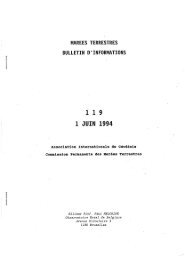marees terrestres bulletin d'informations - Université de la Polynésie ...
marees terrestres bulletin d'informations - Université de la Polynésie ...
marees terrestres bulletin d'informations - Université de la Polynésie ...
Create successful ePaper yourself
Turn your PDF publications into a flip-book with our unique Google optimized e-Paper software.
Importance of the ocean ti<strong>de</strong> mo<strong>de</strong>ling of regional scale in the Earth ti<strong>de</strong> study<br />
Tadahiro Sato<br />
Research Center for Prediction of Earthquakes and Volcanic Eruptions,<br />
Tohoku University<br />
6-6 Aza-Aoba, Aramaki, Aoba-ku, Sendai, 980-8578, Japan<br />
E-mail: tsato@aob.geophys.tohoku.ac.jp<br />
Abstract<br />
This is a summary of an invited talk presented by Sato at the ETS 2008 International<br />
Conference ‘New Challenges in Earth’s Dynamics’ that was held in Jena, Germany in<br />
September 2008. Main part of the presentation is referred to Sato et al. (2008). Recent<br />
improving of the accuracy of the tidal observations and mo<strong>de</strong>l predictions including the ocean<br />
tidal loading (OTL) effects is remarkable. The observed Earth ti<strong>de</strong> data may use to improve the<br />
mo<strong>de</strong>l of the Earth’s insi<strong>de</strong> structure, which exhibits a viscoe<strong>la</strong>stic property as well as the<br />
<strong>la</strong>terally inhomogeneous e<strong>la</strong>stic structure. For these, it is essential to improve the accuracy of<br />
both the global and regional ocean ti<strong>de</strong> mo<strong>de</strong>ls. An attempt in the region of Southeast A<strong>la</strong>ska is<br />
introduced.<br />
1. Accuracy of the global ocean ti<strong>de</strong> mo<strong>de</strong>ls<br />
Based on the Schwi<strong>de</strong>rski’s ocean ti<strong>de</strong> mo<strong>de</strong>l (Schwi<strong>de</strong>rski, 1980), Schenewerk et al. (2001)<br />
computed the ocean ti<strong>de</strong> effects on the vertical components at the IGS-GPS sites in the world,<br />
and compared the observed loading effects. A remarkable point of their comparison results is<br />
<strong>la</strong>rge discrepancy exceeding 3 cm between the observed loading effect of the M 2 constituent and<br />
the computed one along the Pacific coast of A<strong>la</strong>ska.<br />
Thanks to the satellite sea surface altimeters such as TOPEX/Poseidon and Jason-1, the<br />
accuracy of the recent global ocean ti<strong>de</strong> mo<strong>de</strong>ls has been much improved compared with those<br />
in the 1980s. For example, according to Matsumoto et al. (2000), the vector differences for the<br />
M 2 constituent between NAO.99b (Matsumoto et al., 2000) and GOT99.2b (Ray, 1999) are the<br />
or<strong>de</strong>r of 1 cm or smaller than it almost everywhere in the open seas in the world. Matsumoto et<br />
al. (2006) also compared the recent global ocean ti<strong>de</strong> mo<strong>de</strong>ls with the actual ocean bottom<br />
pressure gauge (OBPG) measurements in the western Pacific, off Sanriku in northern Japan, and<br />
they conclu<strong>de</strong> that the difference between the observation and the five global ocean ti<strong>de</strong> mo<strong>de</strong>ls<br />
was less than 1.3 cm in terms of root sum square of the vector differences for eight major tidal<br />
constituents (i.e. Q 1 , O 1 , P 1 , K 1 , N 2 , M 2 , S 2 , and K 2 ). The ocean mo<strong>de</strong>ls they compared are<br />
NAO.99 (an old version of NAO.99b), NAO.99b, GOT99.2b, CSR4.0 (Eanes and Bettadpur,<br />
11751



